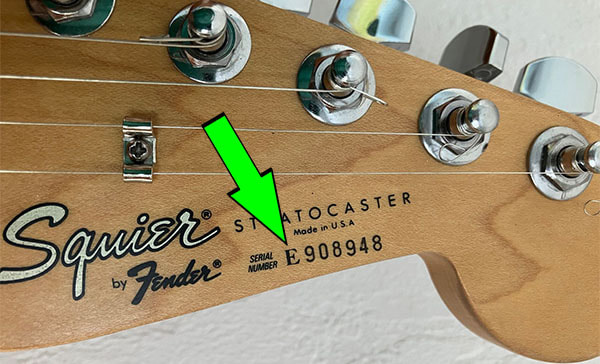THE SQUIER STRATOCASTER MADE IN THE USA
...AND THE SQUIER MADE IN THE MEXICO


|
In the Squier Price List dated January 1991, a surprising entry caught attention: a Squier Stratocaster made in the USA. The earliest Squier US Standard Stratocasters were manufactured in March 1989 and were exclusively sold in the USA - so they were not shipped to Europe. They were last listed in the February 1992 Price List.
There are many guys on various guitar forums that claim Fender started to manufacture these guitars in the USA because of the fire in the Mexican factory of Ensenada, but that fire had nothing to do with their inception because it hit the plant in 1994. |
|
All US Squier Stratocasters featured the same ceramic pickups used for the first Mexican Standard Stratocasters, Ping bridges, and cast/sealed tuning machines, although a few of the very first US Squiers with the all-numerals serial number on the headstock were fitted with vintage-style tuners. Many US Squier strats were equipped with dotted knobs.
|
|
Some early US Squiers had necks marked “Hector Montes”. This led many people to believe they were Custom Shop necks because the same stamp is found on the neck of some Custom Shop Stratocasters of the ‘90s, but they were factory necks and early US Squiers were not prototypes made by the Custom Shop. In fact, in 1989 Hector was not working for the Custom Shop. Furthermore, their necks did not feature the circular logo typical of the early Custom Shop instruments. It’s also important to keep in mind that at that time Custom Shop didn’t have its own neck and body mills as it does today and they shared whatever the production line was doing. Sometimes Custom Shop Master Builders brought those factory necks (and bodies) and made them nicer by sanding the contours, rolling the fingerboards, or doing the rollovers on the headstock. So, having a Hector Montes neck does not mean the neck comes from the Custom Shop, but means Hector shaped that neck.
|
|
Moreover, looking carefully at the body of some US Squier Stratocasters it appears to be the same used for the guitars that recall the Japanese ST-40 but that had a “MADE IN U.S.A.” marking stamped into the wood at the base of the neck (see this article): same routings, same holes in the body, same back plate with middle screw holes that line up horizontally, and same neck pocket with enlarged corners. All these bodies were probably made in Ensenada.
So, the US Squier strats could have served as a trial run for the facility in Mexico, which opened in 1989, although assembly and a few steps of their manufacturing process were completed in the USA. |
|
In 1998, Fender introduced the Squier Standard Stratocaster made in Mexico. The shape of the headstock of this guitar was notably different from that of the US Squier and resembled the “pregnant” shape of the American Standard Stratocaster and Mexican Standard Stratocaster manufactured in the late ‘80s and ‘90s. It's noteworthy that prototypes, test models, and pre-production guitars made in Ensenada in 1989 and early 1990 had a completely different headstock shape because, initially, Ensenada used Japanese machinery—Ensenada was born as a joint venture between Fender USA and Fujigen (for further details, refer to this article).
|

|
© COPYRIGHT 2014-2024 FUZZFACED.NET BY ANTONIO CALVOSA - TUTTI I DIRITTI RISERVATI
La copia, la riproduzione, la pubblicazione e la redistribuzione dei contenuti, se non autorizzate espressamente dall'autore, sono vietate in qualsiasi modo o forma. |

|
© COPYRIGHT 2014-2024 FUZZFACED.NET BY ANTONIO CALVOSA - ALL RIGHTS RESERVED
The copying, reproduction, publication and redistribution of the contents, unless expressly authorized by the author, are prohibited in any way or form. |